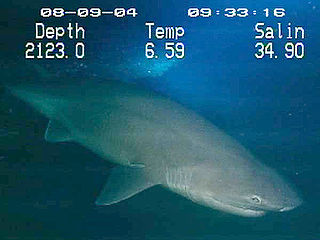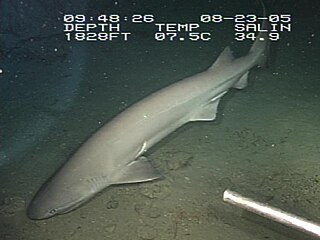
The bullhead sharks are a small order of modern sharks (Neoselachii). The nine living species are placed in a single genus, Heterodontus, in the family Heterodontidae. All are relatively small, with the largest species reaching just 1.65 metres (5.5 ft) in maximum length. They are bottom feeders in tropical and subtropical waters.

The tiger shark is a species of ground shark, and the only extant member of the genus Galeocerdo and family Galeocerdonidae. It is a large macropredator, with females capable of attaining a length of over 5 m. Populations are found in many tropical and temperate waters, especially around central Pacific islands. Its name derives from the dark stripes down its body, which resemble a tiger's pattern, but fade as the shark matures.

The Hexanchiformes are the order consisting of the most primitive types of sharks, and numbering just seven extant species. Fossil sharks that were apparently very similar to modern sevengill species are known from Jurassic specimens.

Cow sharks are a shark family, the Hexanchidae, characterized by an additional pair or pairs of gill slits. Its 37 species are placed within the 10 genera: Gladioserratus, Heptranchias, Hexanchus, Notidanodon, Notorynchus, Pachyhexanchus, Paraheptranchias, Pseudonotidanus, Welcommia, and Weltonia.

The bluntnose sixgill shark, often simply called the cow shark, is the largest hexanchoid shark, growing to 20 ft (6.1 m) in length. It is found in tropical and temperate waters worldwide and its diet is widely varied by region.
The Langhian is, in the ICS geologic timescale, an age or stage in the middle Miocene Epoch/Series. It spans the time between 15.97 ± 0.05 Ma and 13.65 ± 0.05 Ma during the Middle Miocene.
The sixgill sharks are a genus, Hexanchus, of deepwater sharks in the family Hexanchidae. These sharks are characterized by a broad, pointed head, six pairs of gill slits, comb-like, yellow lower teeth, and a long tail. The largest species can grow up to 8 m long and weigh over 600 kg (1320 lb). They are continental shelf-dwelling and abyssal plain scavengers with a keen sense of smell and are among the first to arrive at carrion, together with hagfish and rattails. They show a characteristic rolling motion of the head when feeding.

The bigeyed sixgill shark is a cow shark of the family Hexanchidae. Its dorsal surface has a brownish-gray color, and is sharply separated from the light coloring of its ventral surface. The eyes are a fluorescent green while the shark is alive. The body of this shark is small, slim, and fusiform in shape. As the name suggests, this shark has six gill slits, unusual among most shark species. The head is narrow and somewhat flattened, and the mouth contains 5 rows of large, comb-shaped teeth. This shark's single dorsal fin is pushed back towards the caudal fin, and is behind the pelvic fins. The upper caudal fin is much longer than the lower, with a deep notch near the tip. All fins have thin white margins on the edge. In juveniles, the upper caudal fin has a black tip.

The Caribbean roughshark is a rough shark of the family Oxynotidae, found on the upper continental slopes of the Caribbean Sea, at depths between 400 and 450 m. It reaches a length around 50 cm (20 in).

The angular roughshark is a rough shark of the family Oxynotidae.

Polyopisthocotylea is a subclass of parasitic flatworms in the class Monogenea.
Protocotyle euzetmaillardi is a species of monogenean of the family Hexabothriidae.
The Temblor Formation is a geologic formation in California. It preserves fossils dating back from the Late Oligocene to the Middle Miocene of the Neogene period. It is notable for the famous Sharktooth Hill deposit.
The Tirabuzon Formation is a geologic formation in Mexico. It preserves fossils dating back to the Neogene period, Pliocene epoch.
Protocotyle is a genus of monogeneans in the family Hexabothriidae. The genus was created by Louis Euzet and Claude Maillard in 1974.

The Atlantic sixgill shark is a rare species of hexanchid shark found in the Atlantic Ocean at depths that are greater than 300 meters. These depths are known as mesopelagic and bathypelagic in tropical and temperate waters around the world. The Atlantic sixgill shark is very similar to other species of sixgill in terms of its growth rate in deep sea waters. It is believed that this is due to the abiotic and biotic factors in relation to the depths at which they are found. It was formerly described as its own species, but was synonymised with the bigeye sixgill shark. However, a study published in 2019 resurrected the species on the basis of molecular data. The species can be physically differentiated from the bluntnose sixgill shark by its much smaller size and position of the dorsal fin in relation to the caudal fin. The Atlantic sixgill shark becomes sexually mature at around 1.40 to 1.75 meters. They do not reach lengths much greater than 180 cm.

Macrorhizodus is an extinct genus of Mackerel shark which lived during the early to middle Eocene epoch of the Paleogene period. It is often considered ancestral to Isurus and sometimes considered part of it. Macrorhizodus is also likely ancestral to Cosmopolitodus. It seems to be related to Isurolamna. It is known from isolated teeth and vertebral centra as well as at least two associated dentitions. It is an incredibly widespread shark, known from every continent except Australia. This includes a report from Antarctica.
This page is based on this
Wikipedia article Text is available under the
CC BY-SA 4.0 license; additional terms may apply.
Images, videos and audio are available under their respective licenses.









